
Characteristics of Living Organisms (1.1-1.5)
All living organisms undergo:
Movement: when an organism or part of it changes its place/position
Respiration: Biochemical reaction in cells that breakdown nutrient molecules for (energy) metabolism
Sensitivity: Detection of a stimulus and ability to respond
Growth: Permanent increase in cell size, number or complexity
Reproduction: Creation of offspring of the same species as the parents
Excretion: Removal of toxic materials, waste products from metabolic processes or substances in excess
Nutrition: Intake of substances required for growth and to provide energy
MRS GREN will help you remember!
Viruses are NOT considered living organisims because they do not complete these processes
Viruses are non-cellular and consist of genetic material surrounded by a protein coat
They reach target cell and inject this genetic material into the cell, which will then replicate to reproduce the virus harming the target cell
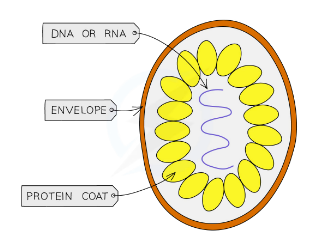
Classification systems
Classification is used to group species
Species: group of organisms that can be bred to reproduce fertile offspring
Organisms are divided based on MORPHOLOGY and ANATOMY
Morphology: Study of external characteristics
Anatomy: Study of internal characteristics
DNA sequencing studies give a more accurate comparison
DNA of each species is mapped and compared; species with similar ancestors will have closer DNA base seqences
Binomial Nomenclature: a system of nomenclature in which each species of animal or plant receives a name of two terms
Second part is the SPECIES and is all in lowercase letters
First part of the name is the GENUS and will always start with an uppercase letter
The order of classification of organsims is: Kingdom, Phylum, Class, Order, Family, Genus, Species
KING PHILIP CAME OVER FOR GRAN’S SPAGHETTI ;)
The Five Kingoms:
Animal
Plant
Fungus
Prokaryote
Protoctista
Cell Structures
Cells of all living organisms contain:
Cytomplasm
Cell membrane
DNA as genetic material


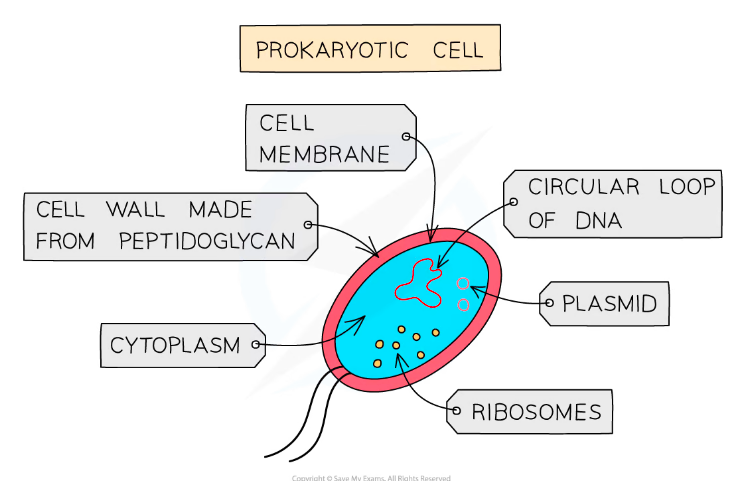
Kingdom: Plants
Autotrophs: Living organisms that synthesize organic molecules from simple inorganic substances (through photosynthesis)
Photosynthesis: Carbon Dioxide + Water → Glucose + Oxygen
6CO2 + 6H2O → C6H12O6 + 6O2
Classifying Plants
Algae: No leaves, roots or stem and contains chlorophyl
It is photosynthetic; using the energy of the sun to change carbon dioxide and water into food and oxygen.
Ferns: Do not produce flowers
No true roots, stems or leaves but have ‘fronds’ instead
Reproduces through spores
Mosses: No vascularisation (xylem/phloem)
No true leaves but have phyllids instead, no roots or stems (anchored by rhizoid)
Reproduces by spores and sporangia
Gymnosperms: Has vascularisation
Has (true) leaves, roots and stems
Reproduces through cones
Angiosperms: Has vascularisation
Has (true) leaves, roots and stems
Reproduces through flowers
Angiosperms can be further divided into monocots and dicots
Monocots | Dicots |
|---|---|
One cotyledon (seed leaf) | Two Cotyledons (seed leafs) |
Parallel Veins on leaves | Network of veins on leaves |
Scattered vascular bundles | Ring of Vascular bundles |
Flower petals in multiples of 3 | Flowers in multiples of 4/5 |
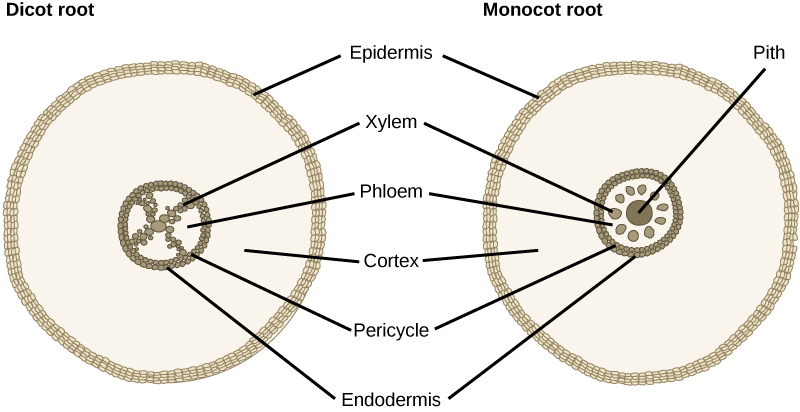
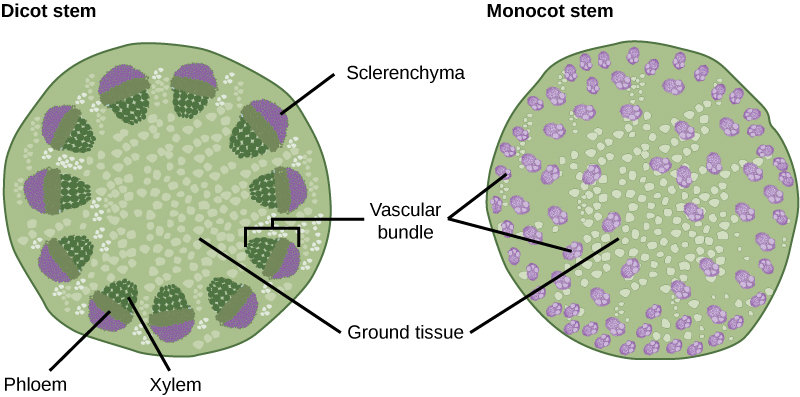
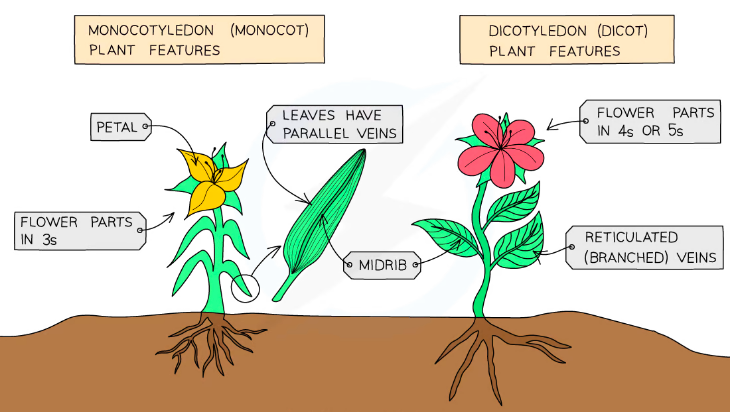
Least developed →Most developed
Algae → Mosses → Ferns → Gymnosperms → Angiosperms
Kigdom: Fungi
Either unicellular (eg. yeat) or multicellular (eg. dandruff, mushroom or mould)
Structure of fungi:
Grow as thread like filaments called hypha which intertwine to make up the mycelium
Cell wall is made of chitin (or cellulose)
Reproduce asexually by producing spores which can be dispersed by water, wind or other organisms OR can be shot out by sporangia
Feed on dead decaying organic matter; saprophytic
Kingdom: Animals
All animals are heterotrophs: feed on organic molecules
The animal kingdom is divided into VERTEBRATES ( have a backbone) & INVERTEBRATES (no backbone)
Invertebrates
Arthropods
Common features of arthropods
Segmented body
Hard exostkeleton
Many pairs of jointed legs
Arthropods are divided into : Crustacea , Insects, Arachnids, Myriapods
Crustacea:
Many Body segments
Stalked compound eyes
2 pairs of antennae as sense organs
Insects
Divided into 3: head, abdomen, and thorax
1 Pair of antennae as sense organ
Pair of compound eyes; wider vision
3 Pairs of jointed legs
Arachnids
2 body segments: Clepathorax and abdomen
No antennae; Pair of pincers to hold food
4 Pairs of legs
No compound eyes
Myriapods
Centipedes are carnivorous- 1 pair of legs per segment
Millipedes are herbivorous- 2 pairs of legs per segment

Nematodes
No body segements
Moves by wrigglign but lives in one place
Parasitic; organism that lives on or in a host organism and gets its food from or at the expense of its host
Soft bodied
Annelids
Long segmented body covered in mucus
Chaete (bristles) on each segment for movement
Hard, waterproof body covering
Herbivorous
Molluscs
Have a shell that protects soft body
Eyes on tentacles
Mouth part to scrape vegetation
Foot muscle with slimy covering for movement
Vertebrates
Fish (Pisces)
All are aquatic
Cold blooded
Scales for protection
Lateral Line as sense organ and used for balance
Movement through fins
Breathing through gills; covered by operculum
Skeleton is bone or cartillage
External fertilisation; Female lays eggs in water, male sheds sperm over eggs to form zygote that develops into a young fish
Stream lined to facilitate easier swimming
Amphibians
Smooth, Slimy, Naked skin
Cold blooded
Moves using legs/limbs with their hind legs end in webbed feet for swimming under water
External fertilisation
Can live in both land and water
Breathe through skin, mouth and lungs
Reptiles
First true land living vertebrates
Cold blooded
Covered with dry scales for protection
Breathe through lungs
Internal fertilization; lay eggs

Birds/Aves
Warm blooded
Bodies covered by feathers
To trap warm air and provide protection
Quill feathers for wings and plume for the rest of the body
Scales on legs which are tipped with claws
Jaws modified into toothless beaks
Forelegs modified into wings
Hollow bones to decrease body weight and facilitate flying
Internal fertilisation; reproduce through laying eggs
Breathe through lungs; Have extra air sacs to store oxygen
Mammals
Warm blooded
Body covered by hair/fur
Presence of external ear (pinna) to collect sound waves
Females have mammary glands to secrete milk to feed their offspring
Internal fertilization; give birth to live offspring

Kingdom: Prokaryote
Microscopic and unicellular
Some have flagella for movement
No nucleus BUT have circular DNA strands instead
Plasmids and extra chromosomal DNA
Composed of: Outer cell wall made of murien, a cell membrane and cytoplasm
Reproduces asexually by binary fission
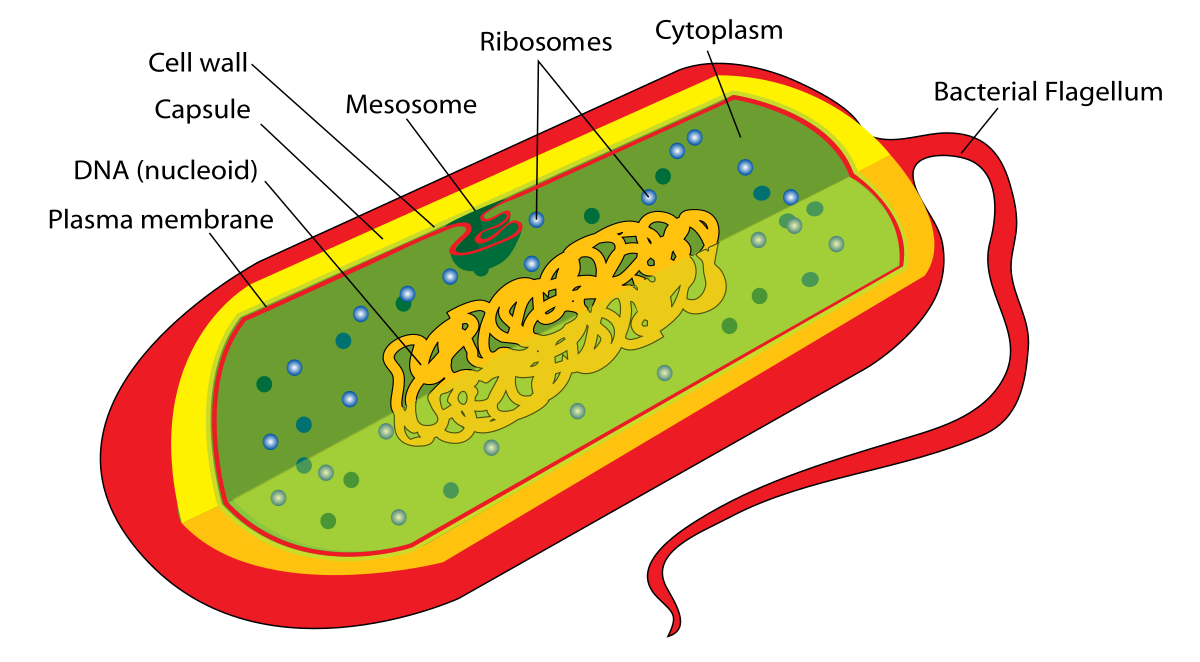
Dichotomous keys
Used to identify species based on a series of questions about their features
A user is presented with 2 questions at a time (hence the name DIchotomous) and is supposed to chose one that correlates with the species
This leads to a pair of other questions
In order to successfully navigate a key, you need to pick a single organism to start with and follow the statements from the beginning until you find the name
You then pick another organism and start at the beginning of the key again, repeating until all organisms are named
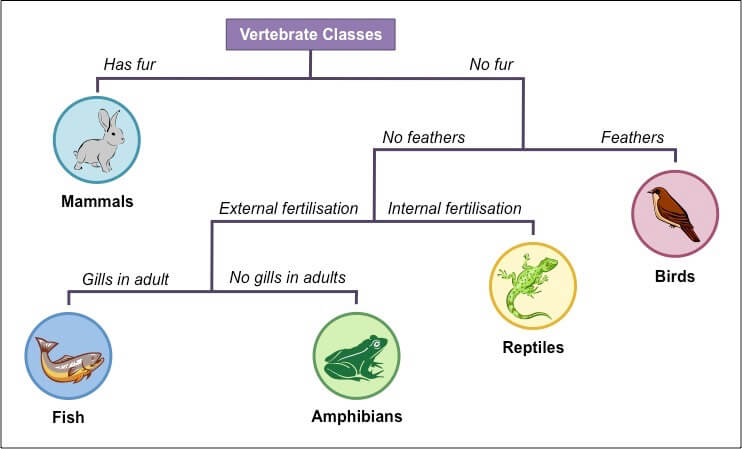
Characteristics of Living Organisms (1.1-1.5)
All living organisms undergo:
Movement: when an organism or part of it changes its place/position
Respiration: Biochemical reaction in cells that breakdown nutrient molecules for (energy) metabolism
Sensitivity: Detection of a stimulus and ability to respond
Growth: Permanent increase in cell size, number or complexity
Reproduction: Creation of offspring of the same species as the parents
Excretion: Removal of toxic materials, waste products from metabolic processes or substances in excess
Nutrition: Intake of substances required for growth and to provide energy
MRS GREN will help you remember!
Viruses are NOT considered living organisims because they do not complete these processes
Viruses are non-cellular and consist of genetic material surrounded by a protein coat
They reach target cell and inject this genetic material into the cell, which will then replicate to reproduce the virus harming the target cell

Classification systems
Classification is used to group species
Species: group of organisms that can be bred to reproduce fertile offspring
Organisms are divided based on MORPHOLOGY and ANATOMY
Morphology: Study of external characteristics
Anatomy: Study of internal characteristics
DNA sequencing studies give a more accurate comparison
DNA of each species is mapped and compared; species with similar ancestors will have closer DNA base seqences
Binomial Nomenclature: a system of nomenclature in which each species of animal or plant receives a name of two terms
Second part is the SPECIES and is all in lowercase letters
First part of the name is the GENUS and will always start with an uppercase letter
The order of classification of organsims is: Kingdom, Phylum, Class, Order, Family, Genus, Species
KING PHILIP CAME OVER FOR GRAN’S SPAGHETTI ;)
The Five Kingoms:
Animal
Plant
Fungus
Prokaryote
Protoctista
Cell Structures
Cells of all living organisms contain:
Cytomplasm
Cell membrane
DNA as genetic material



Kingdom: Plants
Autotrophs: Living organisms that synthesize organic molecules from simple inorganic substances (through photosynthesis)
Photosynthesis: Carbon Dioxide + Water → Glucose + Oxygen
6CO2 + 6H2O → C6H12O6 + 6O2
Classifying Plants
Algae: No leaves, roots or stem and contains chlorophyl
It is photosynthetic; using the energy of the sun to change carbon dioxide and water into food and oxygen.
Ferns: Do not produce flowers
No true roots, stems or leaves but have ‘fronds’ instead
Reproduces through spores
Mosses: No vascularisation (xylem/phloem)
No true leaves but have phyllids instead, no roots or stems (anchored by rhizoid)
Reproduces by spores and sporangia
Gymnosperms: Has vascularisation
Has (true) leaves, roots and stems
Reproduces through cones
Angiosperms: Has vascularisation
Has (true) leaves, roots and stems
Reproduces through flowers
Angiosperms can be further divided into monocots and dicots
Monocots | Dicots |
|---|---|
One cotyledon (seed leaf) | Two Cotyledons (seed leafs) |
Parallel Veins on leaves | Network of veins on leaves |
Scattered vascular bundles | Ring of Vascular bundles |
Flower petals in multiples of 3 | Flowers in multiples of 4/5 |



Least developed →Most developed
Algae → Mosses → Ferns → Gymnosperms → Angiosperms
Kigdom: Fungi
Either unicellular (eg. yeat) or multicellular (eg. dandruff, mushroom or mould)
Structure of fungi:
Grow as thread like filaments called hypha which intertwine to make up the mycelium
Cell wall is made of chitin (or cellulose)
Reproduce asexually by producing spores which can be dispersed by water, wind or other organisms OR can be shot out by sporangia
Feed on dead decaying organic matter; saprophytic
Kingdom: Animals
All animals are heterotrophs: feed on organic molecules
The animal kingdom is divided into VERTEBRATES ( have a backbone) & INVERTEBRATES (no backbone)
Invertebrates
Arthropods
Common features of arthropods
Segmented body
Hard exostkeleton
Many pairs of jointed legs
Arthropods are divided into : Crustacea , Insects, Arachnids, Myriapods
Crustacea:
Many Body segments
Stalked compound eyes
2 pairs of antennae as sense organs
Insects
Divided into 3: head, abdomen, and thorax
1 Pair of antennae as sense organ
Pair of compound eyes; wider vision
3 Pairs of jointed legs
Arachnids
2 body segments: Clepathorax and abdomen
No antennae; Pair of pincers to hold food
4 Pairs of legs
No compound eyes
Myriapods
Centipedes are carnivorous- 1 pair of legs per segment
Millipedes are herbivorous- 2 pairs of legs per segment

Nematodes
No body segements
Moves by wrigglign but lives in one place
Parasitic; organism that lives on or in a host organism and gets its food from or at the expense of its host
Soft bodied
Annelids
Long segmented body covered in mucus
Chaete (bristles) on each segment for movement
Hard, waterproof body covering
Herbivorous
Molluscs
Have a shell that protects soft body
Eyes on tentacles
Mouth part to scrape vegetation
Foot muscle with slimy covering for movement
Vertebrates
Fish (Pisces)
All are aquatic
Cold blooded
Scales for protection
Lateral Line as sense organ and used for balance
Movement through fins
Breathing through gills; covered by operculum
Skeleton is bone or cartillage
External fertilisation; Female lays eggs in water, male sheds sperm over eggs to form zygote that develops into a young fish
Stream lined to facilitate easier swimming
Amphibians
Smooth, Slimy, Naked skin
Cold blooded
Moves using legs/limbs with their hind legs end in webbed feet for swimming under water
External fertilisation
Can live in both land and water
Breathe through skin, mouth and lungs
Reptiles
First true land living vertebrates
Cold blooded
Covered with dry scales for protection
Breathe through lungs
Internal fertilization; lay eggs

Birds/Aves
Warm blooded
Bodies covered by feathers
To trap warm air and provide protection
Quill feathers for wings and plume for the rest of the body
Scales on legs which are tipped with claws
Jaws modified into toothless beaks
Forelegs modified into wings
Hollow bones to decrease body weight and facilitate flying
Internal fertilisation; reproduce through laying eggs
Breathe through lungs; Have extra air sacs to store oxygen
Mammals
Warm blooded
Body covered by hair/fur
Presence of external ear (pinna) to collect sound waves
Females have mammary glands to secrete milk to feed their offspring
Internal fertilization; give birth to live offspring

Kingdom: Prokaryote
Microscopic and unicellular
Some have flagella for movement
No nucleus BUT have circular DNA strands instead
Plasmids and extra chromosomal DNA
Composed of: Outer cell wall made of murien, a cell membrane and cytoplasm
Reproduces asexually by binary fission

Dichotomous keys
Used to identify species based on a series of questions about their features
A user is presented with 2 questions at a time (hence the name DIchotomous) and is supposed to chose one that correlates with the species
This leads to a pair of other questions
In order to successfully navigate a key, you need to pick a single organism to start with and follow the statements from the beginning until you find the name
You then pick another organism and start at the beginning of the key again, repeating until all organisms are named

 Knowt
Knowt
